Last updated: 24th February 2024
Our grand tour of India took us to Jaipur – India’s ancient Royal city and the capital of the state of Rajasthan. It took us 4 hours to reach Jaipur by bus from Pushkar. As we drove into the city we realised it’s another big modern city, until you get to the heart of the old walled city where things get much more interesting. Garth being the photographer absolutely loved Jaipur, there are so many photo opportunities. In this post we thought we’d share our 10 most stunning locations for photoshoots and photography in Jaipur. So come join us on our virtual Jaipur sightseeing tour for Instagrammable photo spots plus some other cool things to do in Jaipur.
Table of Contents
About Jaipur – India’s Royal Pink City
Jaipur is a UNESCO World Heritage Site and one of India’s most photographed cities because it features some of the finest and well-preserved Rajasthan architecture. There’s no need to pack your rose tinted spectacles because when you arrive at the heart of the city everything is pink. A mix of sandstone, terracotta and pink painted buildings. The pink colour was chosen by the Maharaja, Sawai Jai Singh II to impress and welcome Queen Victoria and the Prince of Wales on their tour of India in 1876. He ordered the whole city be painted pink. The law still remains in place to this day to only use pink paint.

The Nakkarkhana Gate looking towards the City Palace in Jaipur
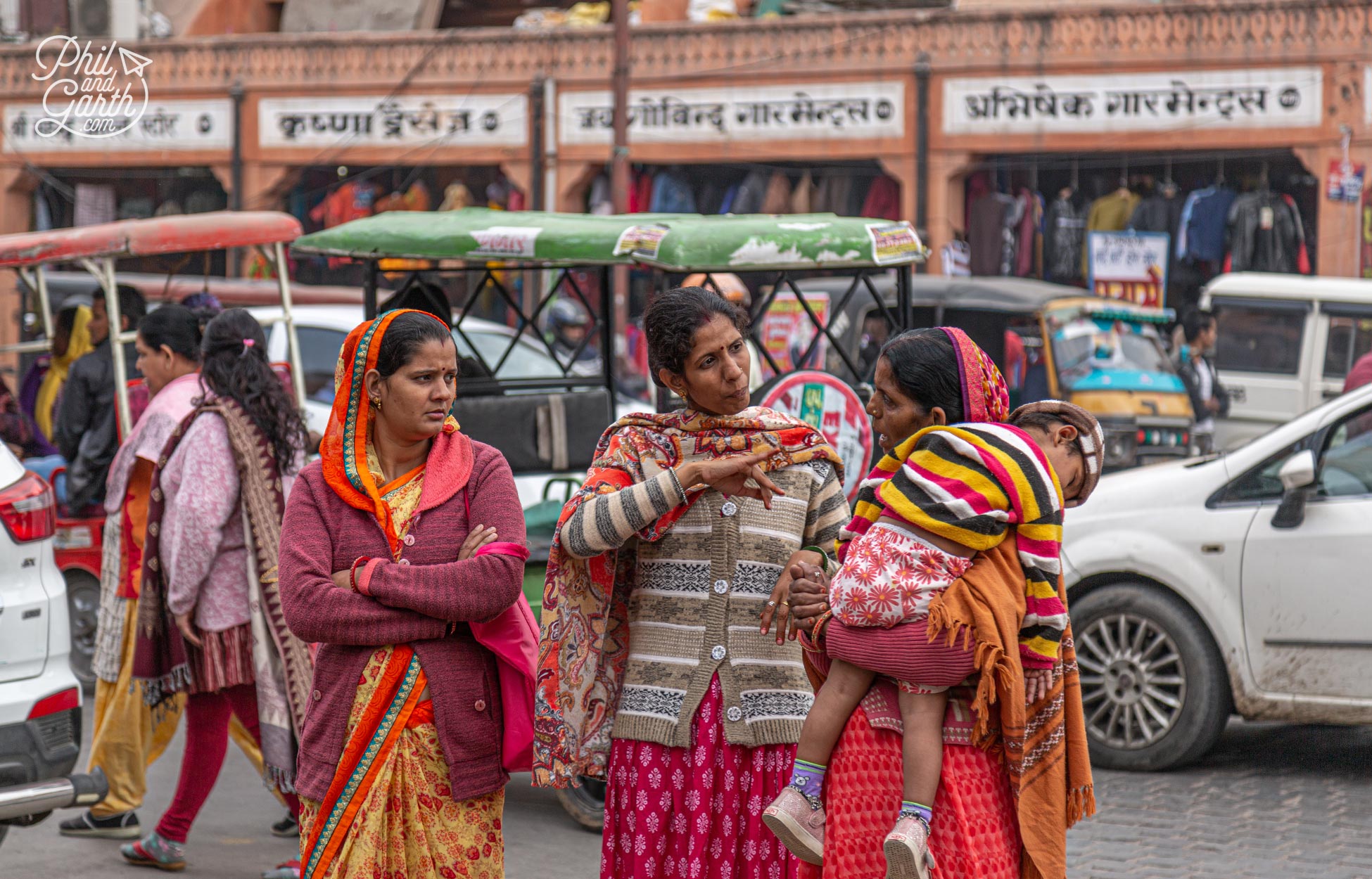
Some ladies chatting on the streets of Jaipur
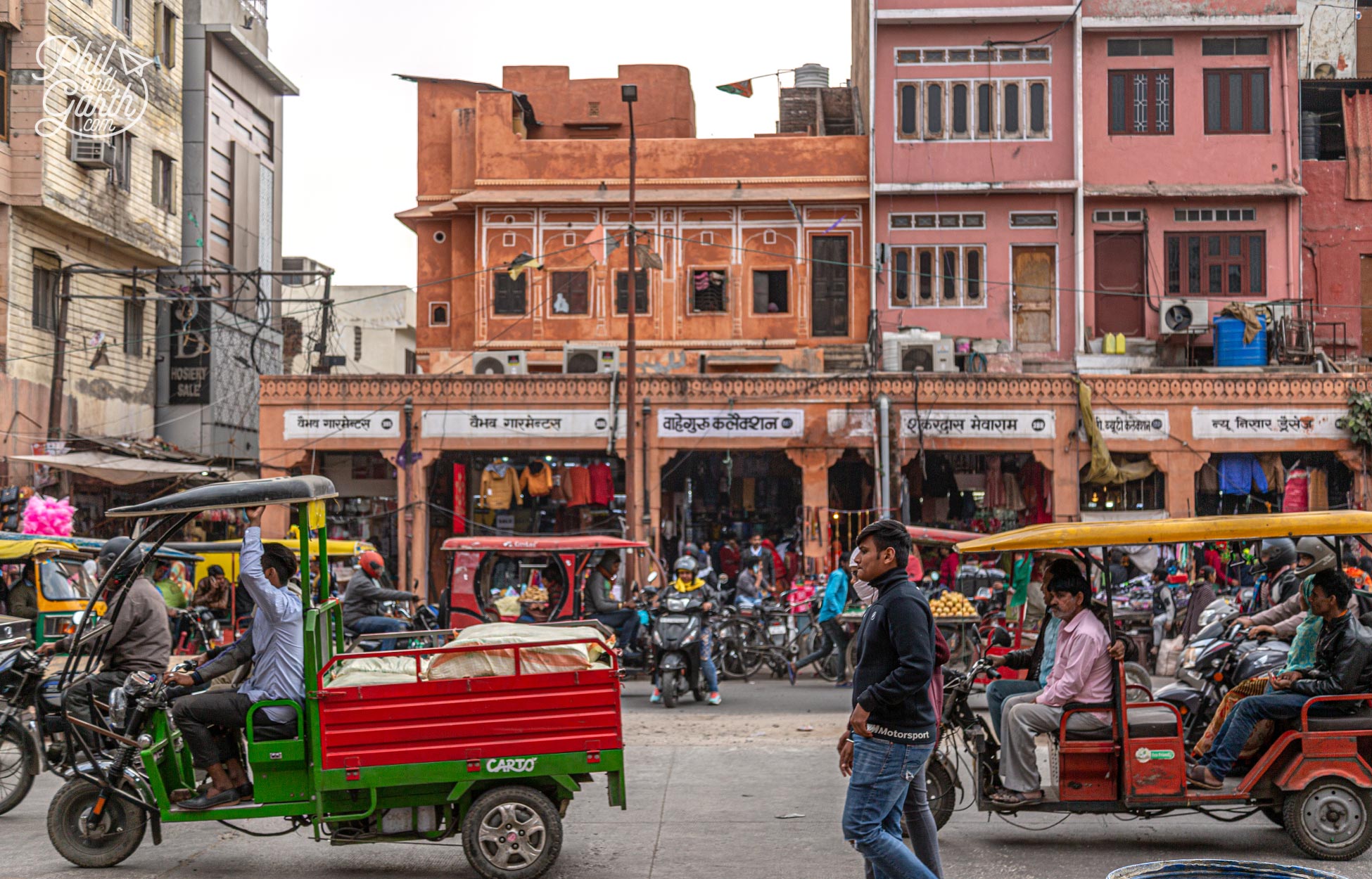
A typical busy street in Jaipur

Jaipur is famous for its palaces, fine jewellery and textiles

The Chand Pol gate is one of the 7 grand entrance gates into Jaipur’s old walled city
Jaipur was India’s first planned city, the idea of the Maharaja Sawai Jai Singh II who in 1727 commissioned an architect to design a simple grid pattern to the principles of Vastu Shastra (India’s version of Feng Shui) with wide and regular shaped roads. Even though roads are big they are still full of crazy traffic.
Just like other Indian cities you have to look beyond the dirt, pollution and desperate poverty. As we walked the streets we mingled with camels, holy cows, stray dogs, wandering pigs on the main roads and even saw monkeys stealing fresh fruit in the markets. Jaipur is colourful and definitely chaotic at times. Before you go make sure you watch the 2011 movie The Best Exotic Marigold Hotel as most of the filming took place in Jaipur and the follow up movie The Second Best Exotic Marigold Hotel.
10 Stunning Photography Locations in Jaipur
1. Hawa Mahal – The Palace of The Winds
Our first sight was one Garth really wanted to photograph – the Hawa Mahal. Built in 1799 from pink and red sandstone this five storey palace looks just like the Ministry of Magic from the Harry Potter movies. It has 365 lattice windows, one for everyday of the year in a honeycomb design. Some have openings to keep the temperatures cool and create a breeze (Hawa) an early form of air-conditioning! hence the name Palace of The Winds.
The windows were used by the women of the Royal family. The Maharaja’s harem would gaze through the lattice windows out onto daily life or royal processions on the streets below without ever been seen. It was only used for this purpose, so unlike other traditional palaces the inside is not lavishly decorated – just a big courtyard, ramps, a fountain and a small museum. Hawa Mahal is really one big facade and is best photographed from the outside.
We went to the The Wind View Cafe opposite for the best views. It has a rooftop balcony and is a really popular spot for photographers and Instagrammers. The Tattoo Cafe next door is also good vantage point for high angle photos. It was nice to sit down with a Coke (remember no ice!) and relax for a bit.
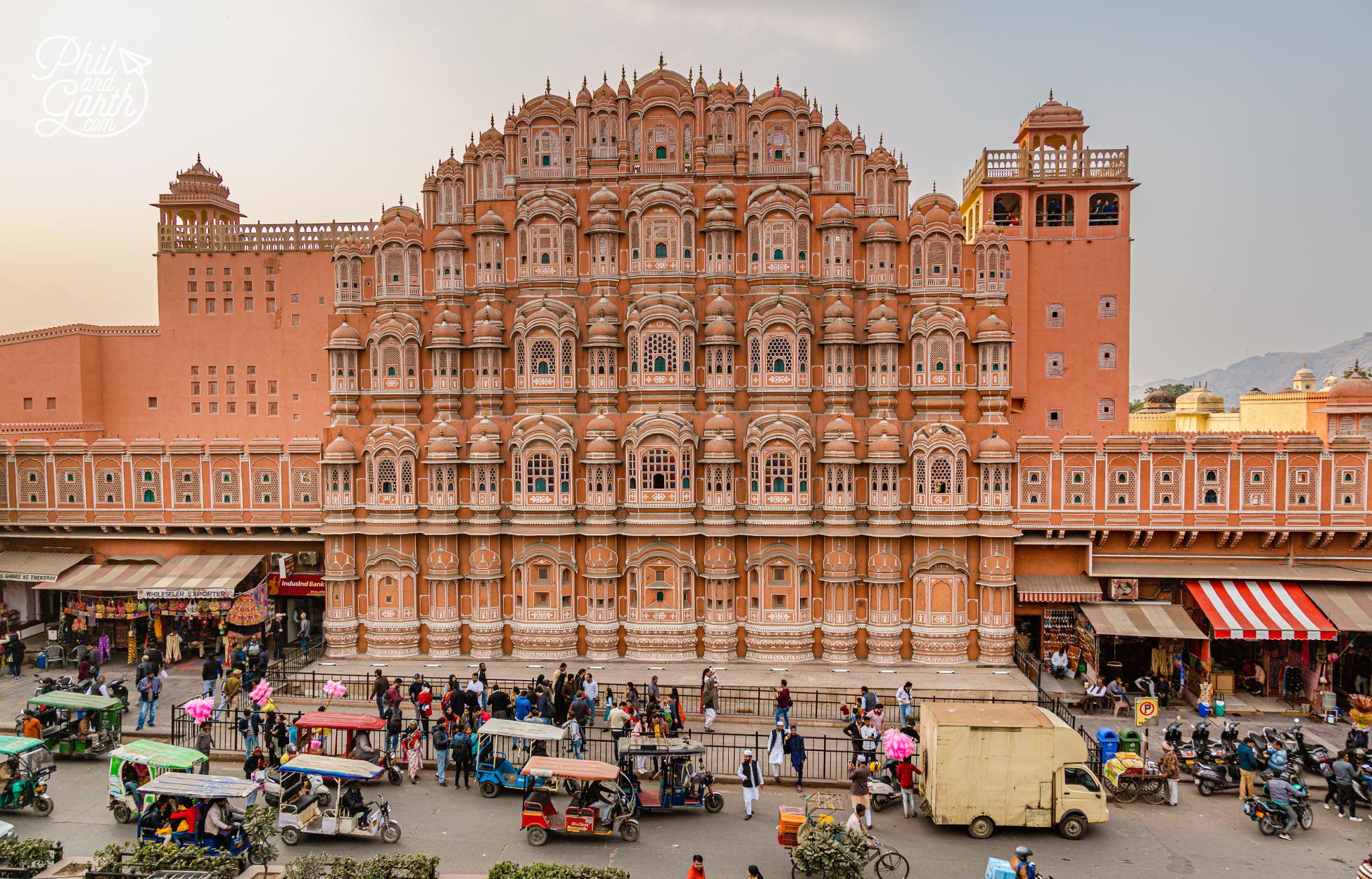
Jaipur’s Hawa Mahal – The Palace Of The Winds

The overhanging bay window balconies are called jharokhas
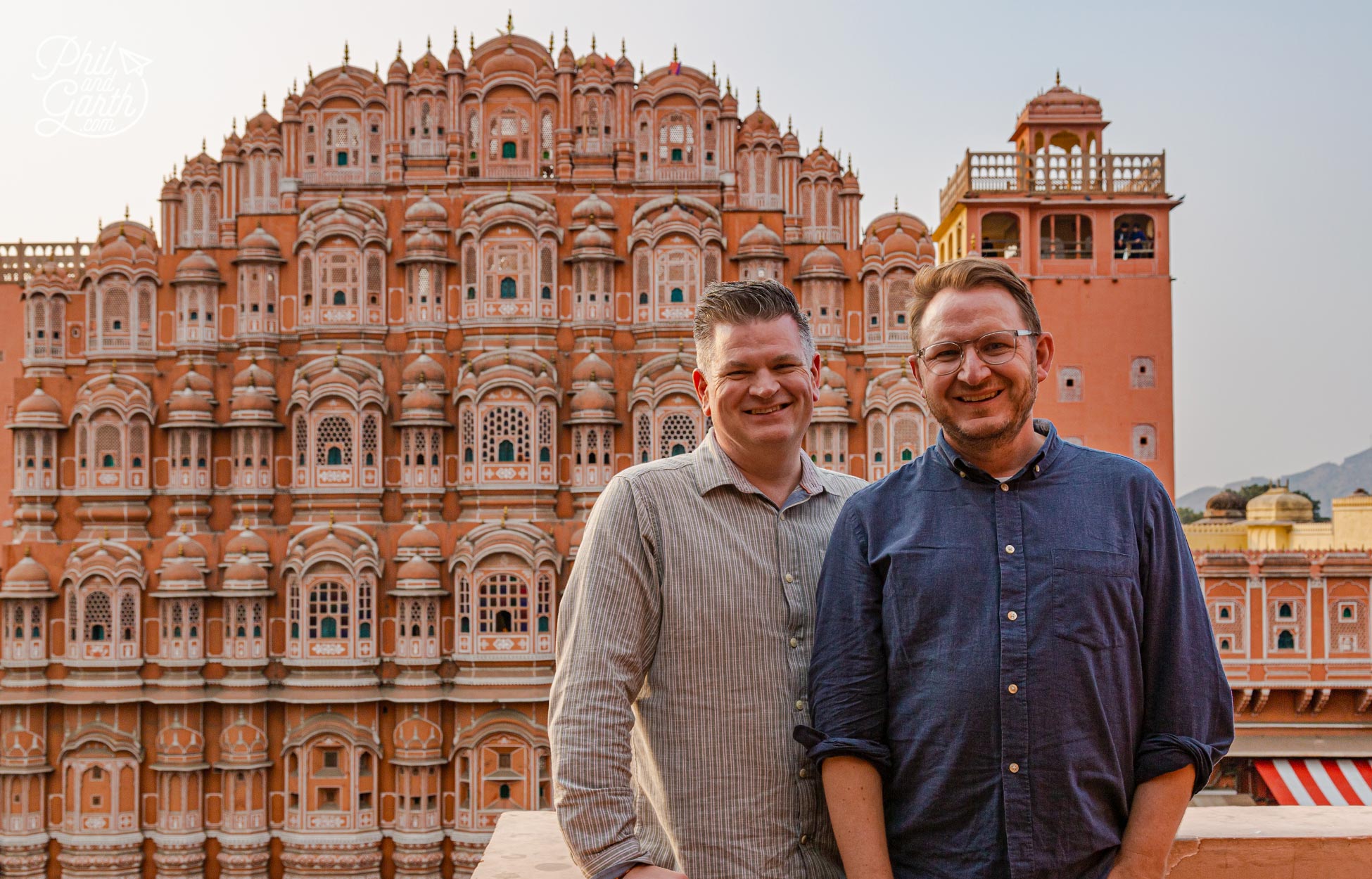
Phil and Garth at Hawa Mahal – Photo taken from The Wind View Cafe opposite

Outside Hawa Mahal are loads of hawkers, including snake charmers!
This area is a mecca for hawkers praying on tourists, including snake charmers, so be aware of your surroundings. One of the cafe owners was very persistent with us and started following us, offering to take our photos in return to going to his cafe.
This area is also incredibly noisy and busy with people. Locals are shouting loudly and there is constant beep of tuk tuk horns. This is one of those chaotic India moments that we’d read about. Phil found the noise quite overwhelming, so we took time out and returned to our hotel for some peace. Don’t be afraid to take time out of a situation when you might be experiencing a bit of culture shock.
2. Amber Fort
The biggest landmark of Jaipur is the stunning Amber Fort also called Amer Fort. It’s located in Amer, 7 miles outside Jaipur’s city centre and takes about 30 minutes by tuk tuk to get there. This imposing fort is perched on Amer Hill and is a UNESCO World Heritage Site. Built in the 16th century it took 100 years to complete, it’s a huge sprawling place divided into 4 levels with a different courtyard on each. It’s considered to be one of the best forts in Rajasthan. We can confirm Amber Fort really is outstanding, it has a real wow factor and is Jaipur’s must see sight. It’s a bit of a climb to the top via 500+ steps which you share with colourfully decorated elephants. We saw lots of people riding the elephants to the fort’s gate just like maharajahs would have. Please don’t do this as we believe animals, especially elephants should not be used for tourism. You’ll need at least 3 hours to see everything.

Jaipur’s imposing Amber Fort also called Amer Fort took 100 years to complete

Male elephants are aggressive so female elephants carry tourists to the fort’s entrance

Looking down on the paradise garden in Maota Lake which was the main source of water for Amber Fort

Amber Fort has the 3rd longest wall in the world – it’s over 7 miles long
As we looked out at the surrounding Aravalli mountains we could see Amber Fort’s wall covers a huge distance. It’s over 7 miles and is the world’s 3rd longest wall. It looks just like the Great Wall of China and reminded us of walking on it when we visited Beijing.
1st Level – Jaleb Chowk, The Soldiers Courtyard
As you enter Amber Fort’s you arrive in the first courtyard called Jaleb Chowk. It’s large and empty – this is where the King’s soldiers would gather and parade. It also has a temple where Kings would go and worship. We got loads of hassle from hawkers and musicians in this courtyard – if it’s not your thing, just give them a firm ‘no thanks!’

The first courtyard you enter was used by the Royal soldiers

View from the first courtyard
2nd Level – The Diplomatic Courtyard
On the 2nd level is the courtyard where the King would meet his ministers and visiting dignitaries. The building with rows and rows of pillars is called the Diwan-e-Aam – The Hall of Public Audience. The main attraction is the highly detailed Ganesh Pol entrance gate. It’s one of Jaipur’s most popular photoshoot spots for couples and influencers. The floral patterns are lovely, Garth really liked the pink and turquoise colour combination. Amber Fort was built using soft yellow, pink sandstone and white marble.

View of Amber Fort’s 2nd courtyard. Impressive Ganesh Pol entrance and Diwan-e-Aam to the left
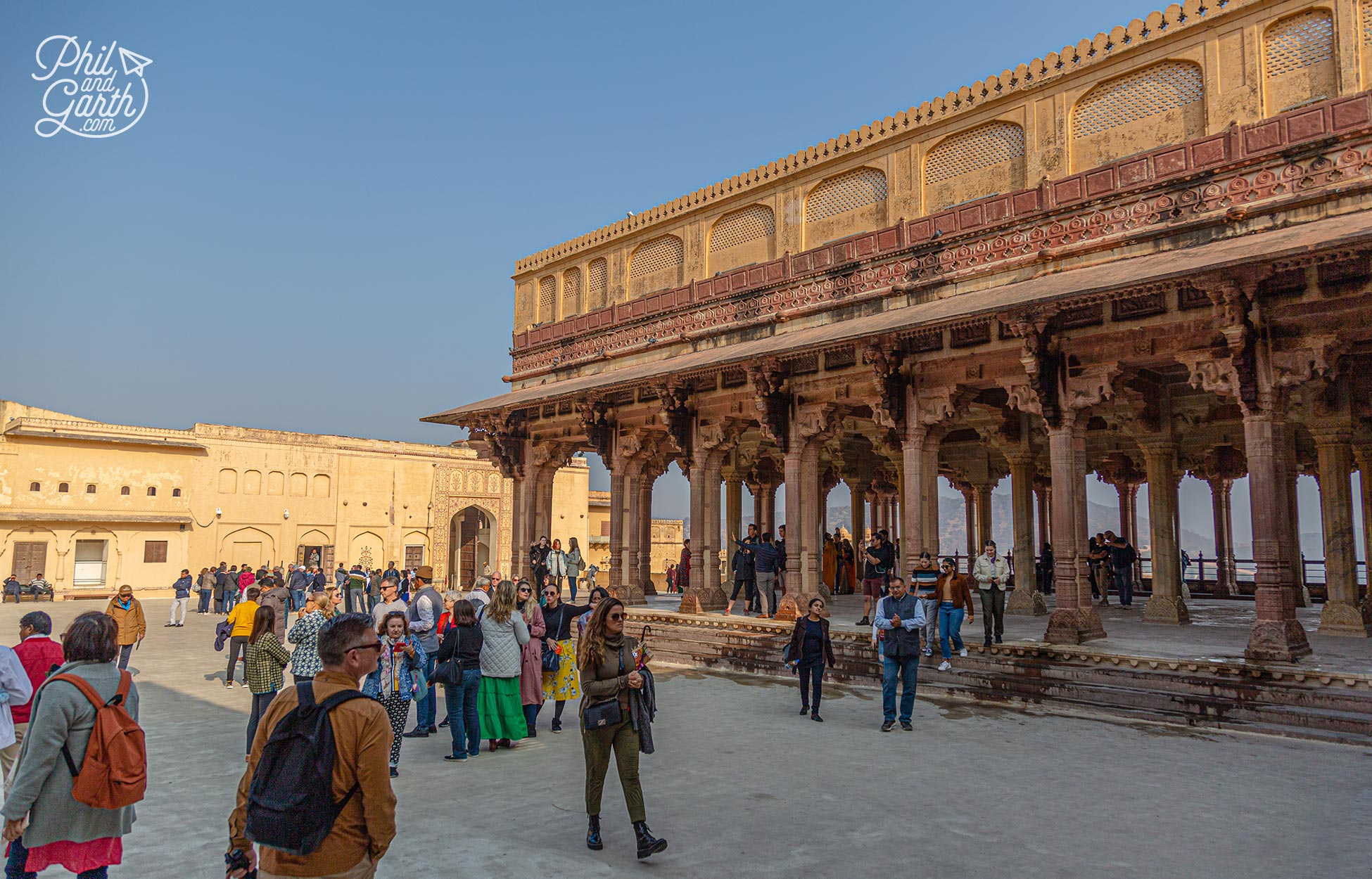
Rows of double columns in the Diwan-e-Aam – The Hall of Public Audience

Gorgeous floral motifs on Ganesh Pol – the entry gate to the 3rd courtyard

The Ganesh Pol gate is one of the most popular backdrops on Instagram – Garth trying to look casual

Phil decided to call these cleaning ladies ‘flickers’ as they just flick dirt around rather than collect it!
3rd Level – The King’s Courtyard
The 3rd courtyard was the private residence for the Royal family. It gave us a real glimpse into how the King with his main 3 wives would have lived. The Sheesh Mahal or better known as the ‘Mirror Palace’ is the real highlight here and is simply exquisite. Hundreds of mosaic pieces of mirror glass from Iran and Belgium decorate the walls and ceilings. Our guide said at night the light of a single candle reflected in the mosaic ceiling looks like a thousand stars.
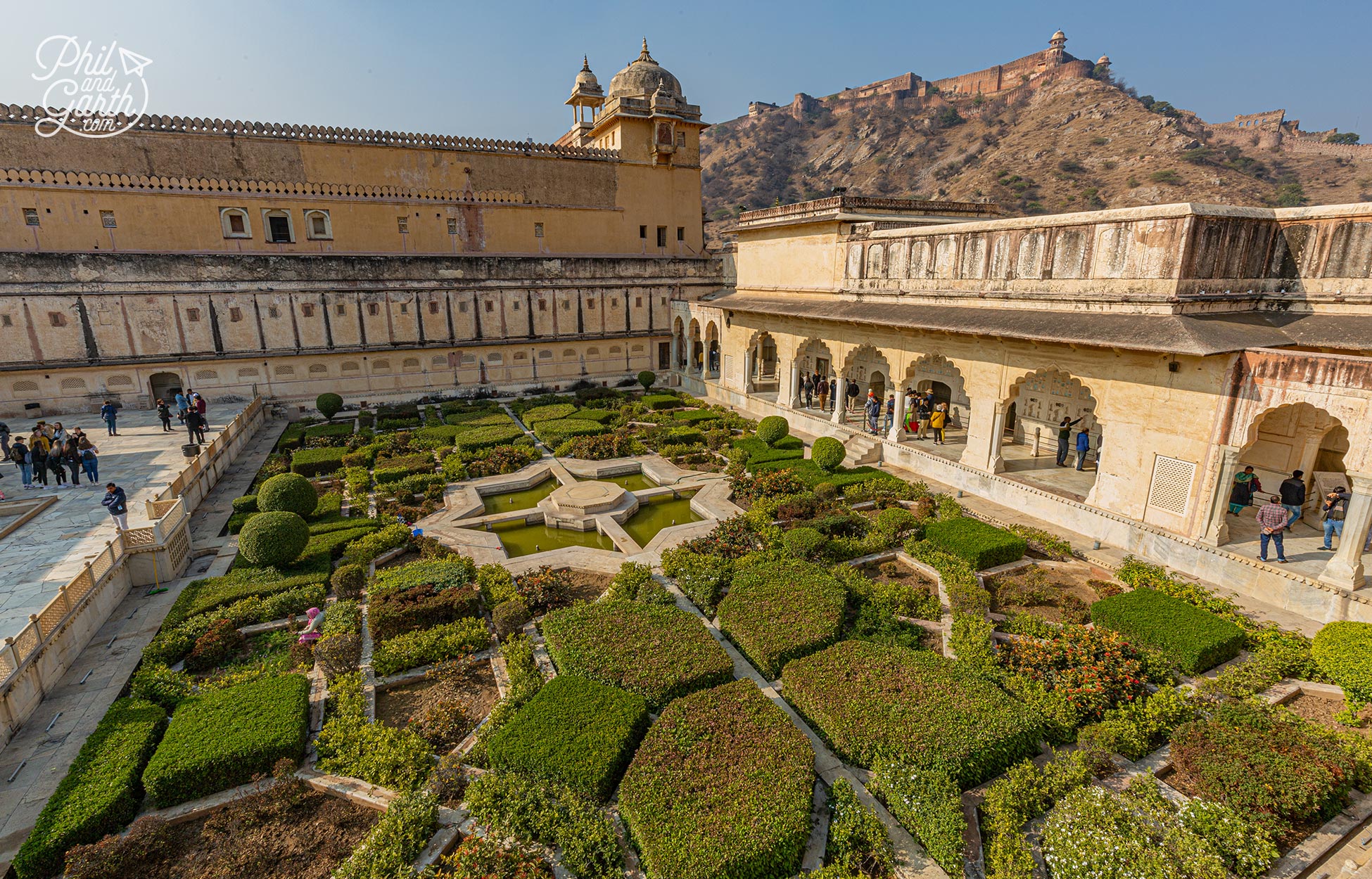
The 3rd courtyard is the King’s courtyard with a secret garden

This small window is where the King’s wives would look on to the 2nd courtyard below without been seen

Garth in front of the glittering mirror palace

The interior of the mirror palace – where the reflected light of a candle looks like thousands of stars

Some details of the mirror palace
4th Level – The Ladies Courtyard
The next courtyard is where the Royal ladies and the mistresses of the King lived. The King had 12 official wives on the records, but multiple more off the record! This courtyard had various rooms for them and a large pavilion where they could meet up. We found the secret passage all the way around so the King could meet a wife of his choice each evening without his other wives ever seeing him!

The 4th courtyard was for the Royal women. They lived here and would meet in the central pavilion

Phil in the shade of the pavilion building

Phil inside a secret passage in the ladies courtyard – it was only used by the King
3. Indian Stepwell – Panna Meena Ka Kund
If you’re visiting Amber Fort then take a short 10 minute walk to the nearby and little known stepwell called Panna Meena Ka Kund. Lots of villages in North India had these ancient stepwells were where people went to collect water. It’s basically a giant reservoir to collect water during the monsoon season. It has a fabulous geometric design, so no matter what the water level was the symmetrical stairways would get you there. It’s off the beaten path, but our Amber Fort guide knew where it was and took us there. The best part is there are no tourists here, so we got some great photographs.

You’re not allowed to go on the steps, however some Instagrammers have been known to bribe the guard

The symmetry of the stairs make it looks like an Escher optical illusion painting
4. Jal Mahal
On your way back to Jaipur from Amber Fort ask your tuk tuk driver to stop for photos of the stunning Jal Mahal palace located in the middle of Lake Man Sagar with a backdrop of the Rahargarh Hills. Jal Mahal means “Water Palace”.

Jal Mahal – photo taken on the way back to Jaipur after visiting Amber Fort
5. City Palace
Located in the old part of Jaipur is the City Palace, built in 1729 by Maharaja Sawai Jai Singh. Over the years later Maharajas added various wings and pavilions. It costs 700 INR (£7.10) to visit the palace’s few buildings including a museum displaying artefacts from Royal costumes, weapons to miniature paintings. There’s also a couple of courtyards and the most immaculately dressed guards we’ve ever seen. You can only take photographs in the courtyards and only see a small part of the palace complex because it’s the still the home of the present Maharajah of Jaipur. It’s still an impressive palace to visit however we thought the city palace in Udaipur was much better. Some areas were closed off because they also hire it as a venue for weddings, wow what a venue!
We loved the large pink walls with tasteful decorations. It’s a blend of Rajput and Mughal architectural styles. Our highlight was the inner courtyard called Pritam Niwas Chowk. It has 4 beautiful peacock themed entrance gates that symbolise the 4 seasons and Hindu gods:
- The Peacock Gate has lots of peacock motifs, it represents autumn and is dedicated to Lord Vishnu.
- The Lotus Gate has lotus petal and flower patterns representing summer and is dedicated to Lord Shiva.
- The Green Gate or Leheriya Gate represents the colour of spring and is dedicated to Lord Ganesh.
- The Rose Gate has repeating rose patterns depicting winter and is dedicated to Goddess Devi.

Here we are in front of the Lotus Gate – the summer gate dedicated to Lord Shiva

Look for the small idol of Lord Shiva above the door
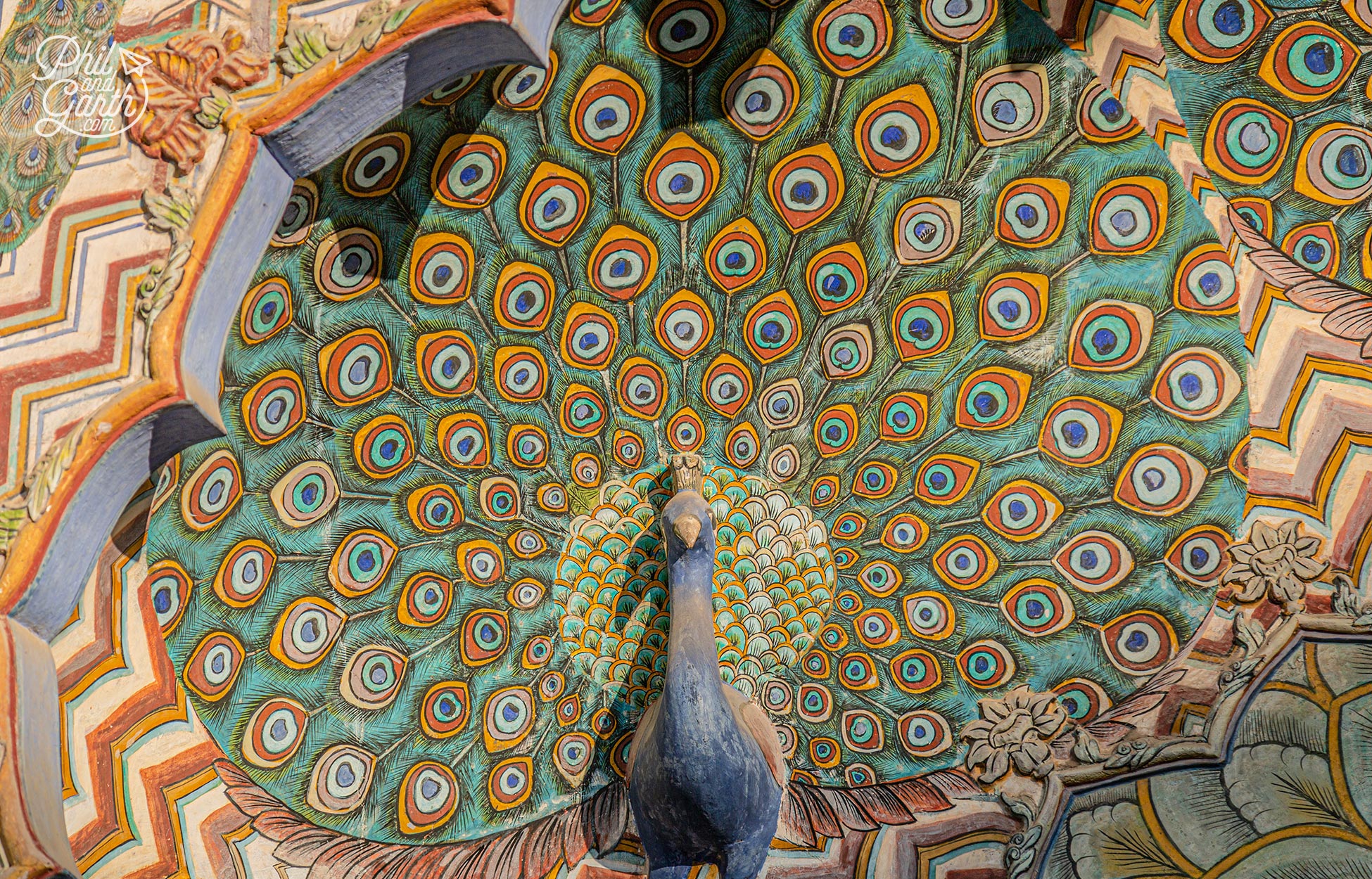
The peacock is the national bird of India. A symbol of beauty and love
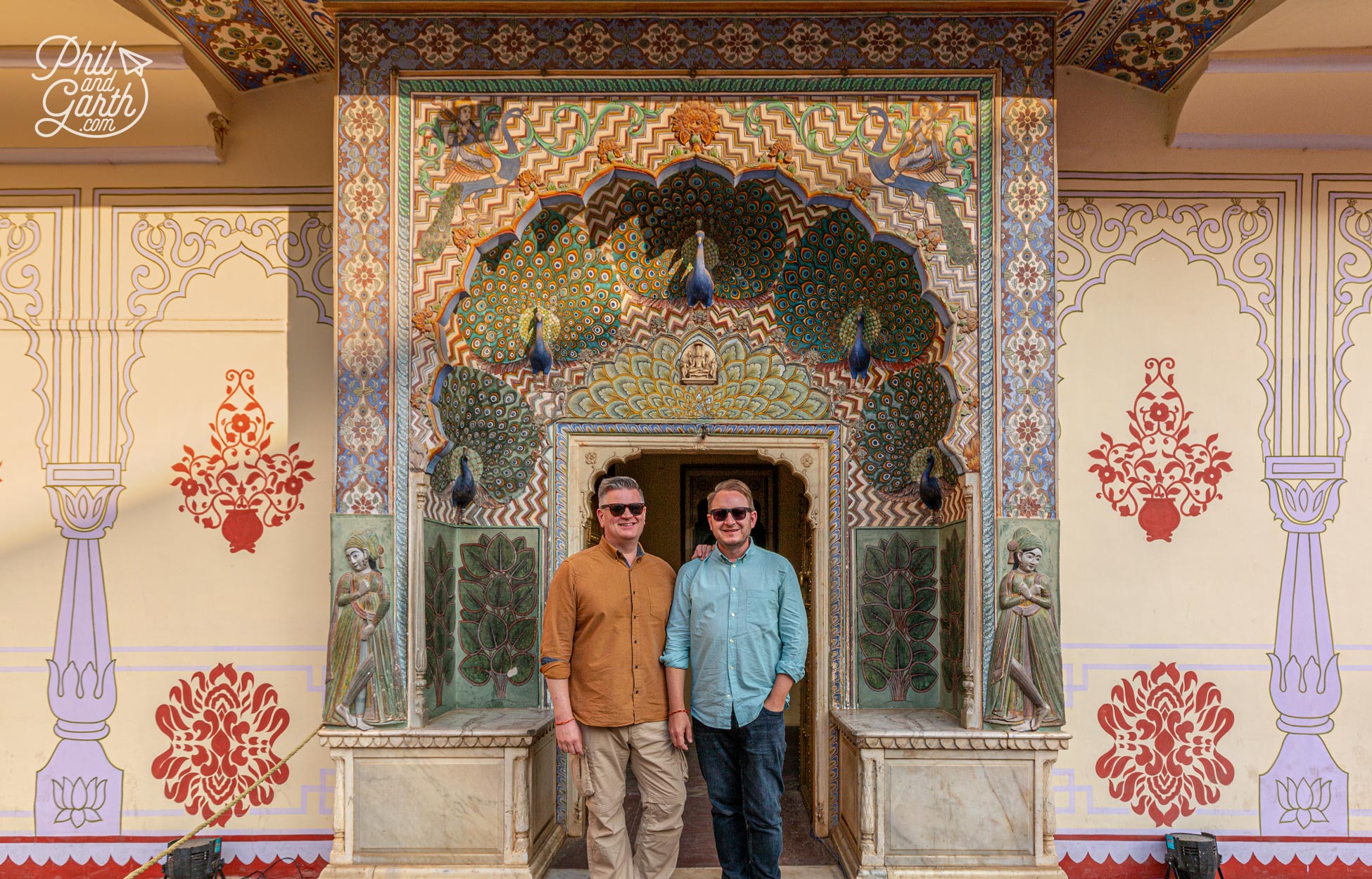
The peacock gate representing Autumn is just beautiful
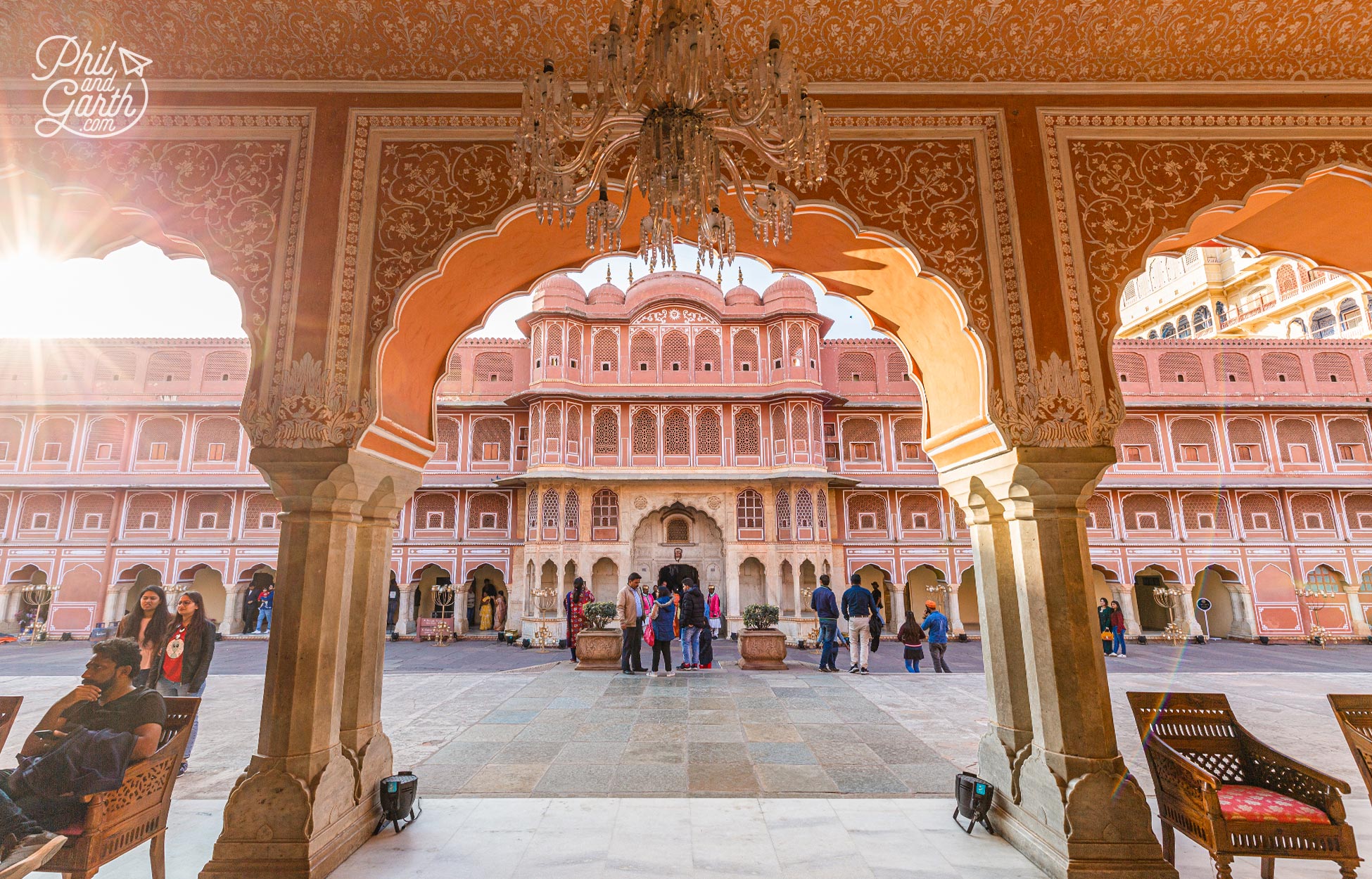
View from inside the Diwan-E-Khas – an audience hall with artwork and glass chandeliers
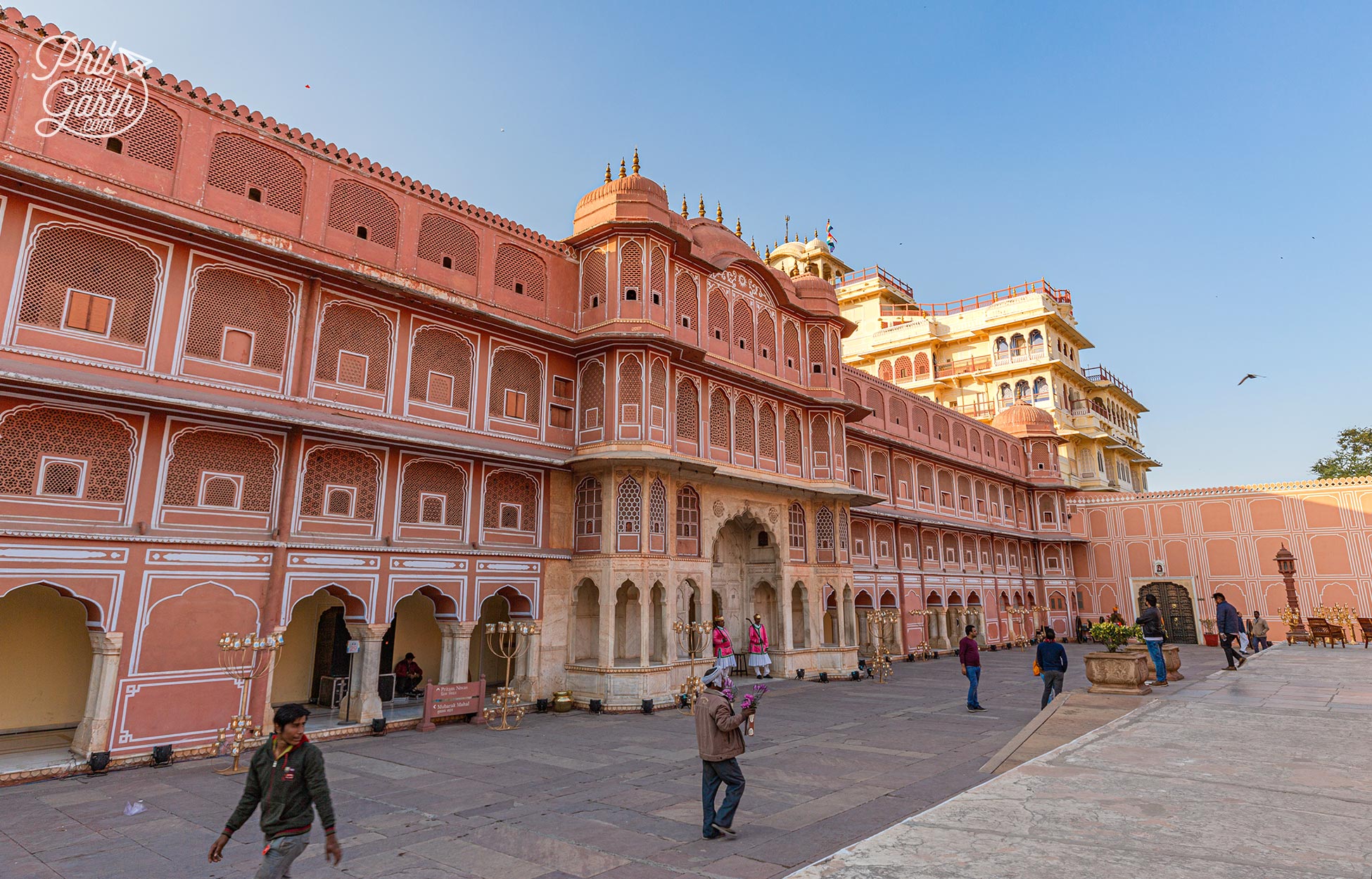
Look at the top of the yellow building – if you see 2 flags flying it means the King is in residence

The City Palace museum
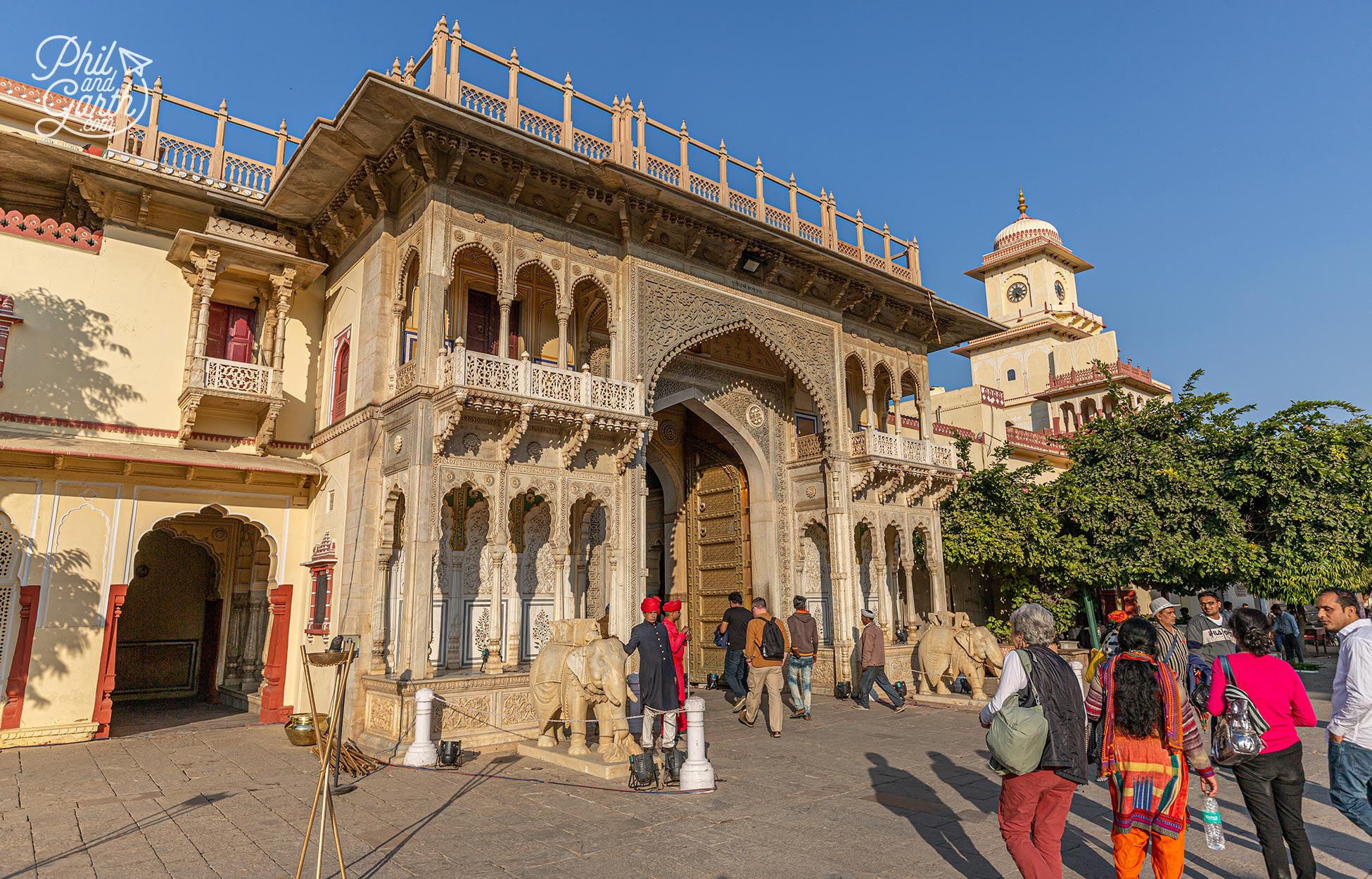
Udai Pol – the entrance gate to the City Palace

The most immaculately dressed guards
6. Jantar Mantar
Right next to the City Palace is an open air astronomical observatory completed in 1734 by the Maharaja Jai Singh, who was a keen astronomer. He also built observatories in Delhi and Varanasi – 5 in total across Northern India.
Jantar Mantar is the second UNESCO World Heritage Site in Jaipur. The 19 giant bizarre looking structures are instruments designed for measuring by eye the time down to 5 seconds and calculate planetary movements. The main stone sundial is the largest in the world. The sharp angles of these geometric structures make the place look really contemporary.
How on earth did they come up with these instruments?! it’s mind boggling, Phil was fascinated by the feat of engineering. It reminded us seeing the incredible Chichen Izta in Mexico – the Mayans also had a fascination with astronomy.
Jantar Mantar is a great place to take abstract photographs, all the weird shapes of the instruments make for unusual compositions.

Phil standing on the steps of one of the Jantar Mantar astrological instruments

The Jantar Mantar structures in Jaipur
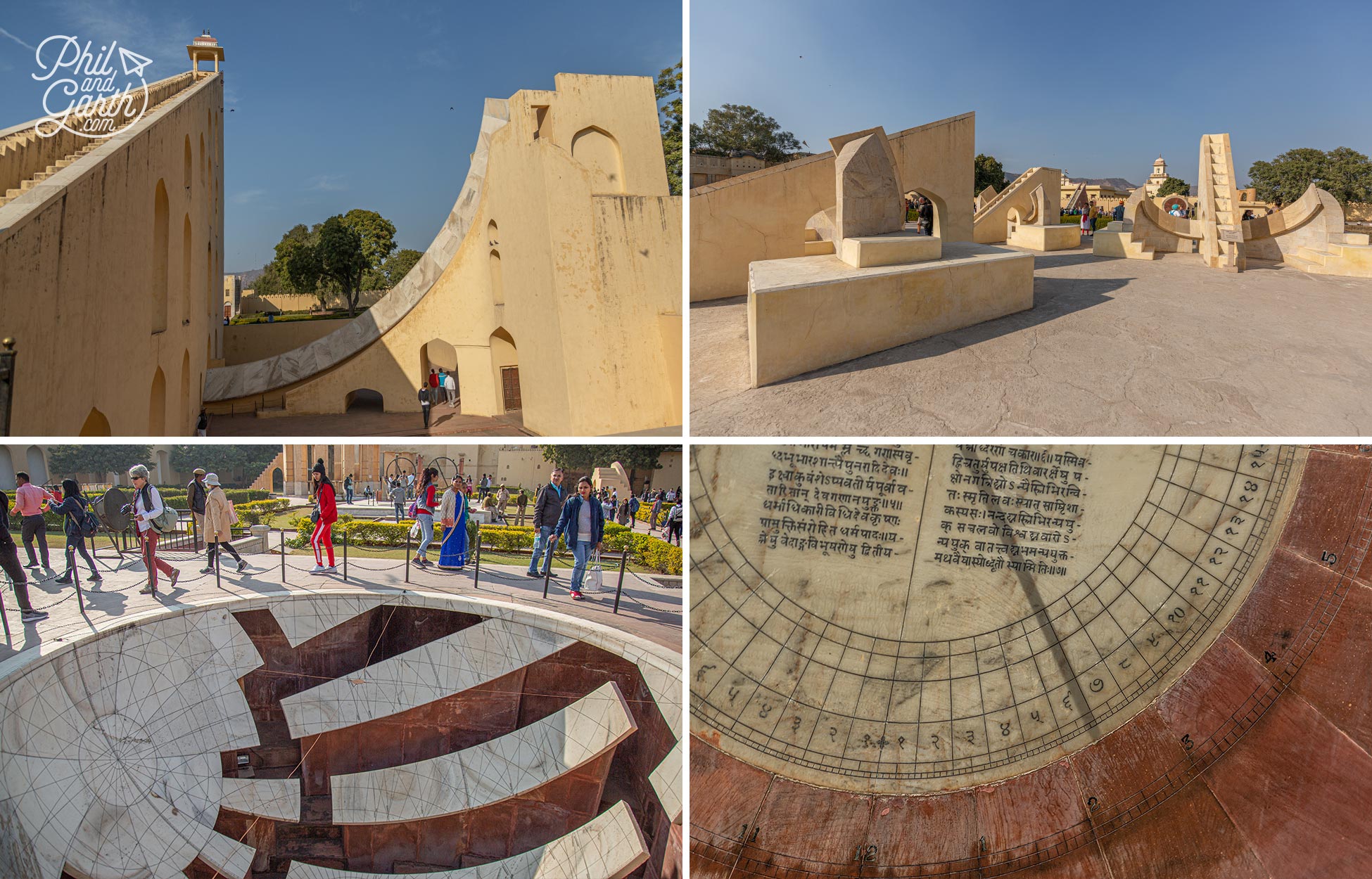
Make sure you have a guide to explain how they all work
7. Go Shopping at Jaipur’s Chandpole Bazaar
Back in Jaipur’s Old City, there’s lots of different markets to explore that are open 7 days a week. We explored the Chandpole Bazaar the oldest at nearly 300 years old. It’s one of Jaipur’s best markets located on both side of the roads between Choti Chapuad and the Chandpol Gate.
We didn’t really want to buy anything, we just wanted to see and photograph what sort of exotic things we could find. Surprisingly it was one of favourite experiences in Jaipur because of the sights, the smells and the sounds as we walked the full stretch of shops. The pavements have a canopy to provide shade in the hot summer months and are incredibly busy with local people. It’s super busy and chaotic in places so be mindful and keep an eye on your belongings.
We loved the exotic smells from the spice shops, sweet shops and street food vendors. We couldn’t believe how our breath was taken away at a chilli shop. There are loads of clothes shops and even a coffin shop.
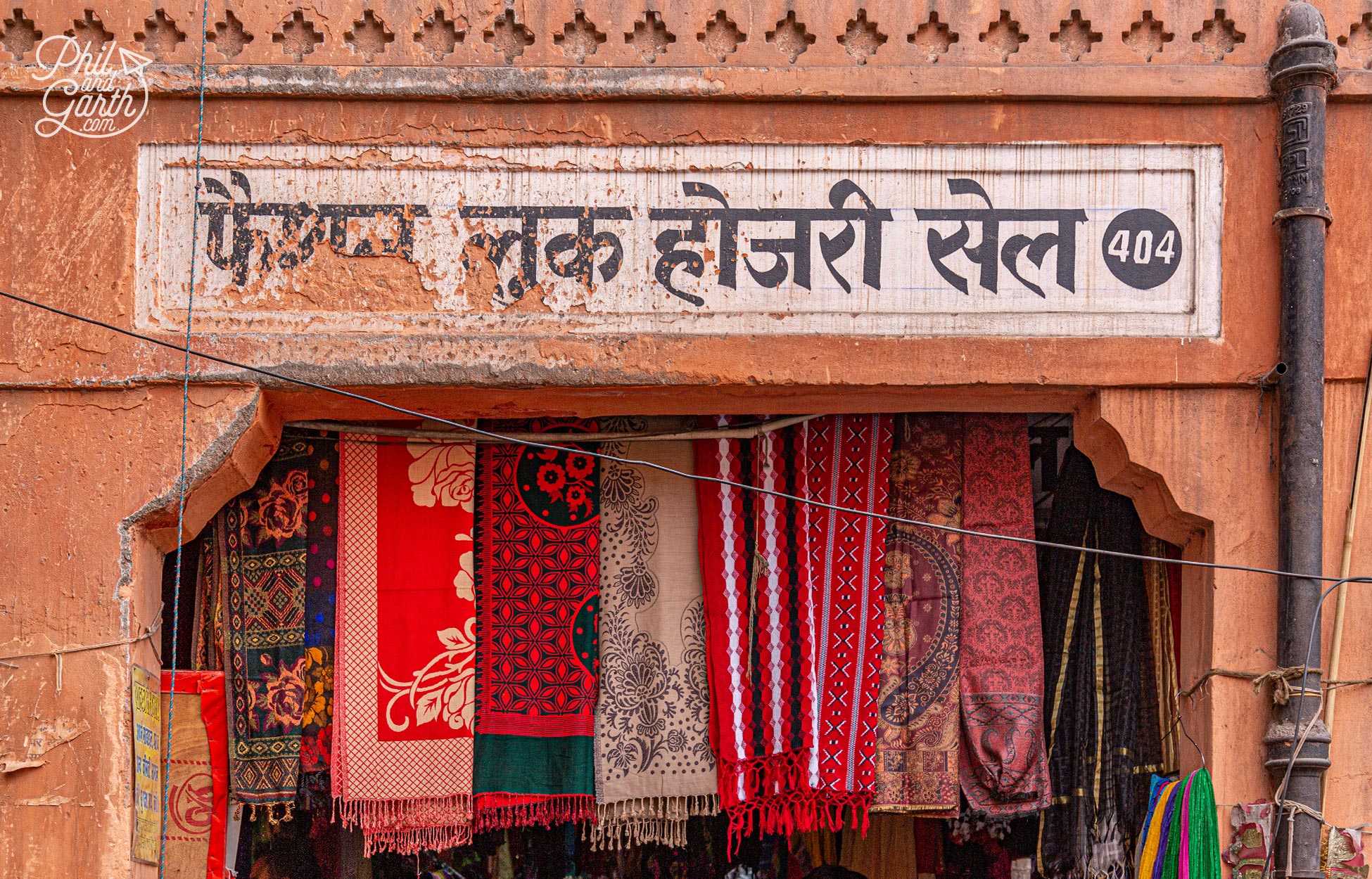
A shop selling textiles at the Chandpole Bazaar

Not sure what this guy was selling

Little trays of sugar coated cumin seeds and roasted fennel seeds

Colourful poppadoms for sale
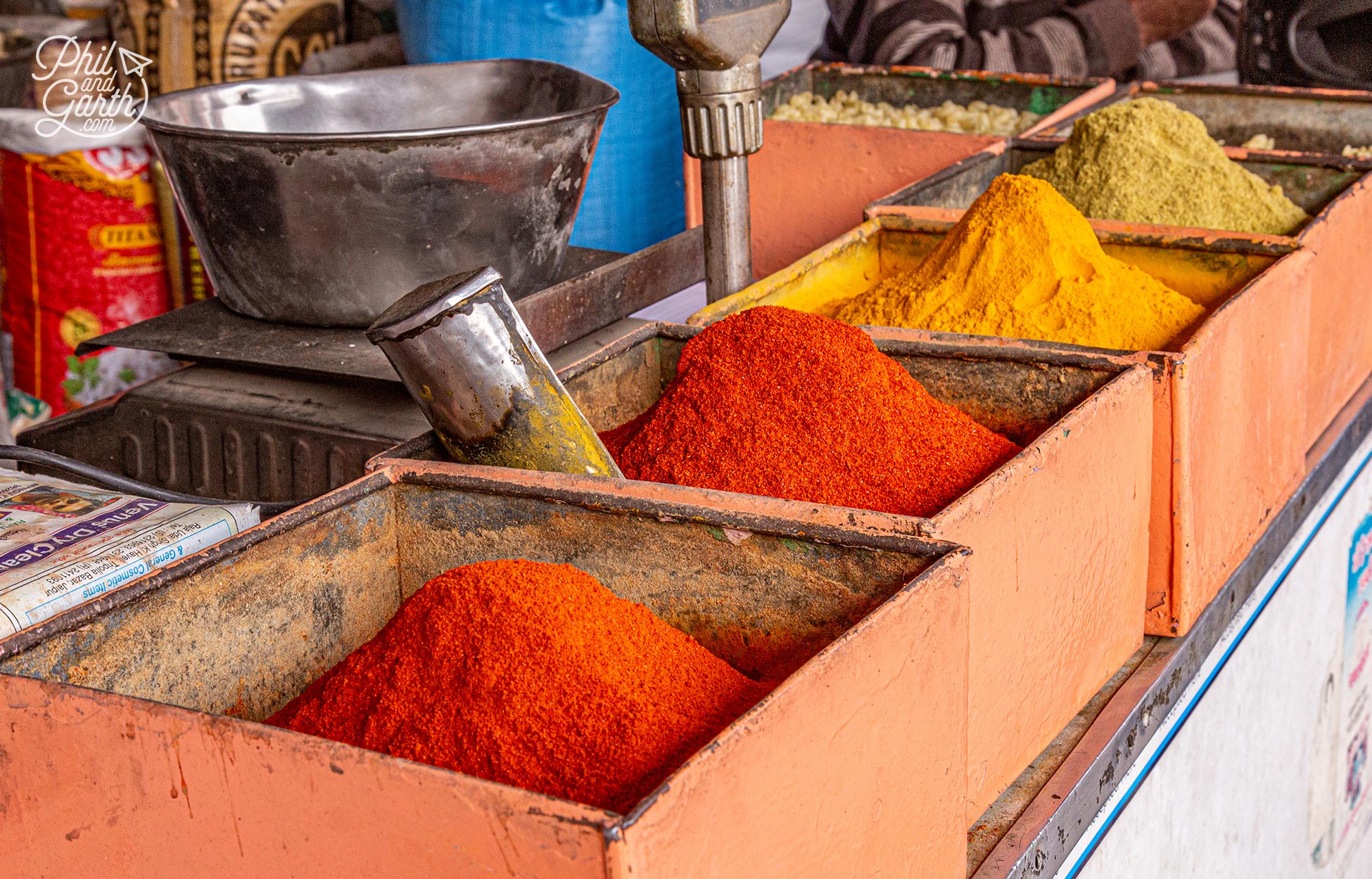
So many different spices for sale

A shop selling loads of chillies at the Chandpole Bazaar

The Chandpole Bazaar shops line each side of the road
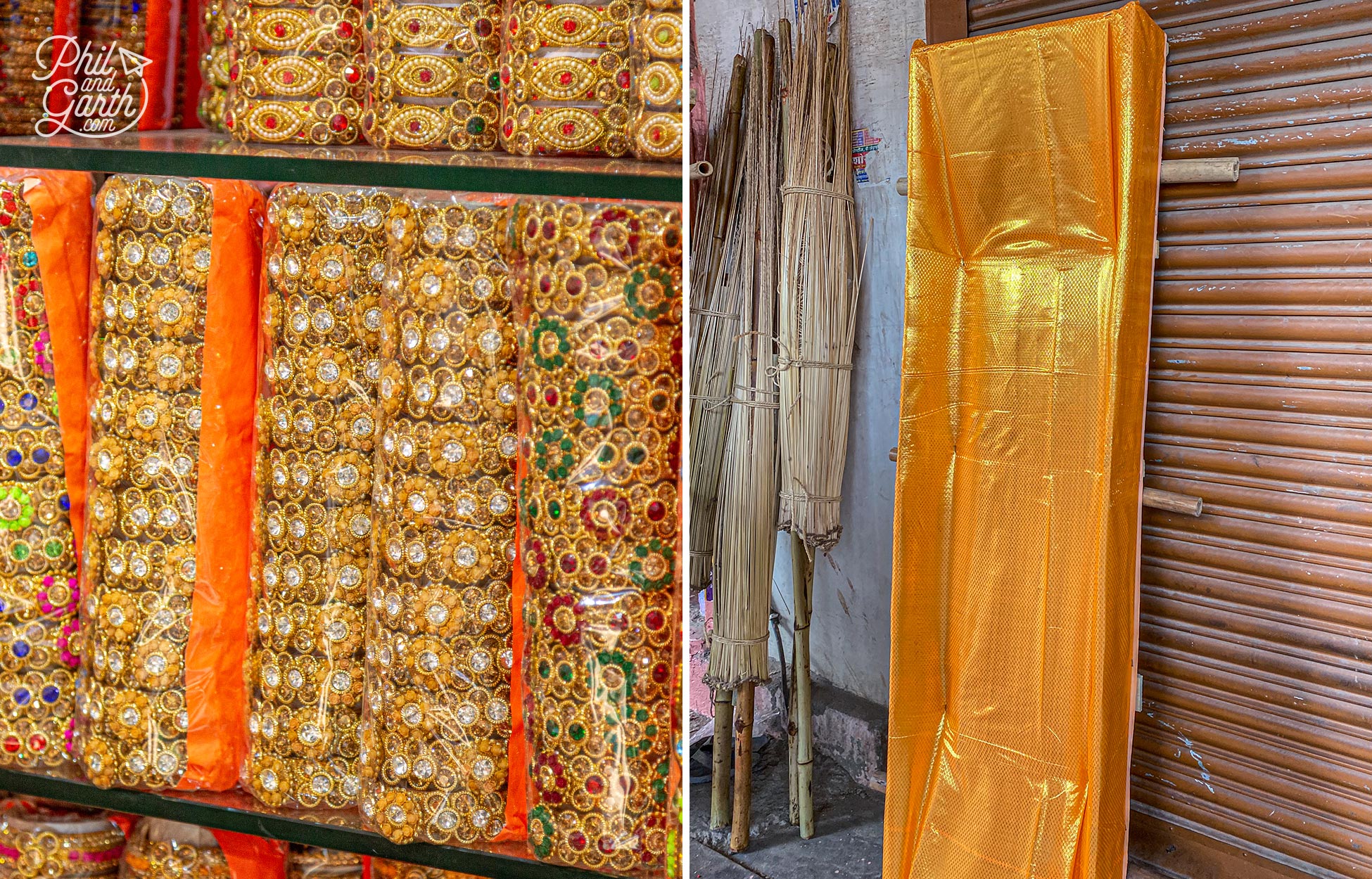
Bling bling bangels and a simple but bling coffin for sale
Jaipur’s Most Popular Bazaars
- Sireh Deori Bazaar – For textiles, puppets and Indian shoes called joothis.
- Bapu Bazaar – Popular for leather goods including camel leather slippers & textiles.
- Johri Bazaar – For jewellery and traditional Rajasthani ornaments.
- Tripolia Bazaar – For antiques and handicraft items.
- Chandpole Bazar – Clothes, saris, and wholesale loose foods.
- Nehru Bazaar – For jootis, bangles and necklaces.
8. Visit A Fabric Factory & Order A Made To Measure Suit, like Phil!
Our tour leader to us to a hand block printing factory with an old and unassuming entrance. It opened into a world of colour, absolutely fascinating inside. It’s a great place to take photographs of fabrics close up. The sales guy showed us how they made hand printed fabrics, incredible to see the speed and accuracy of one of the workers. Also interesting that this small factory made fabrics for well know high street shops including Spain’s Zara and Britain’s Monsoon.
Upstairs their shop had so many textiles and fabrics to choose from. On the spur of the moment Garth decided to treat Phil to a custom made suit! They brought in 2 tailors to measure Phil up. One to do the shirt and trousers and the other to do the jacket. Phil chose a suit made from Marino wool and chose a lining fabric design, that we realised when we later went to the Taj Mahal matched the decoration around the entrance, what a fluke! We now refer to it at the Taj Mahal suit! We ordered it at 1.30pm and it arrived biked to our hotel at 9.15pm with a guy to make sure everything was ok – all for £150. Amazing value for such good quality.

Learning about hand block printing at the Mughal India Crafts factory
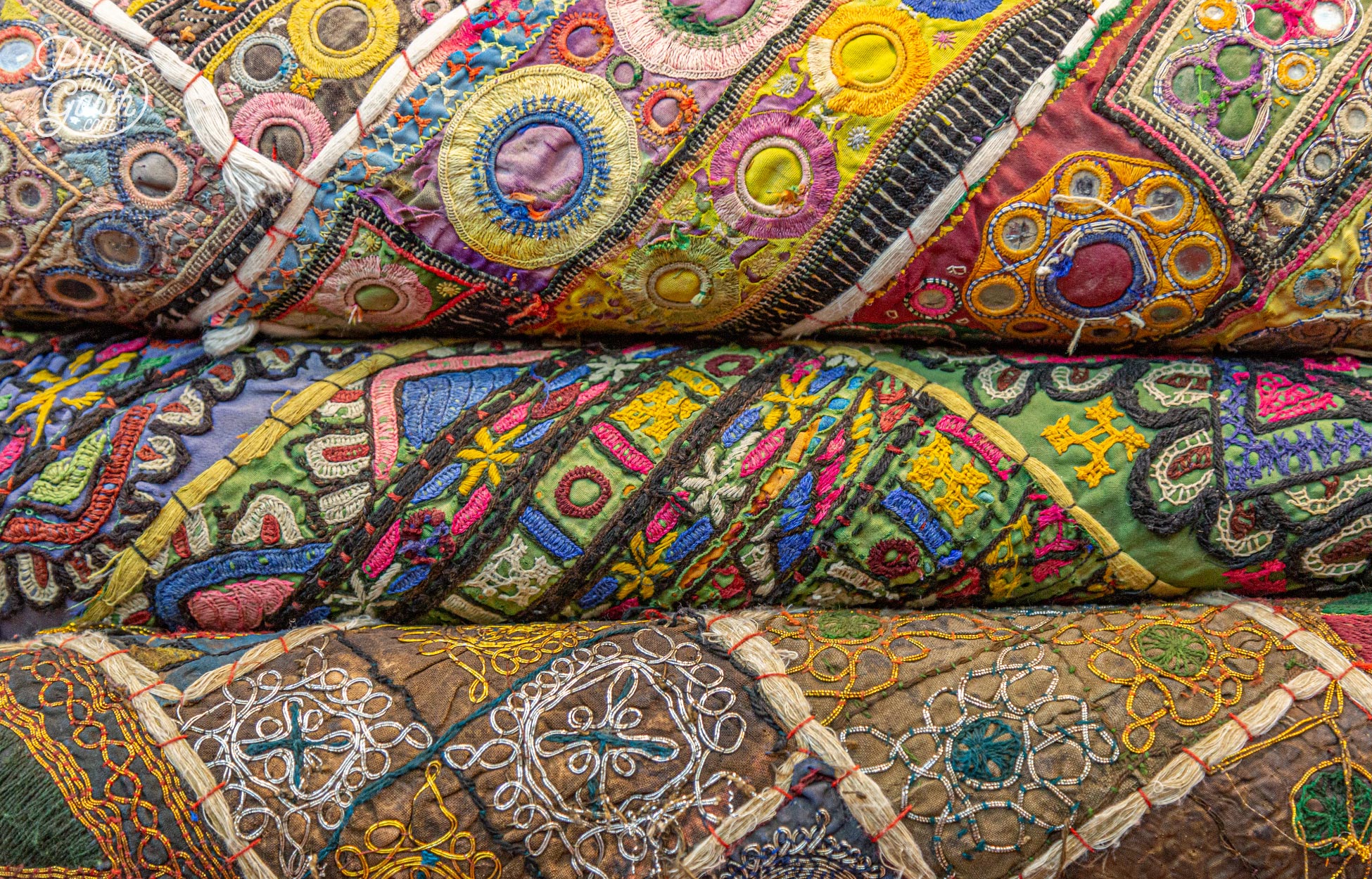
Wonderful Indian textiles and colour
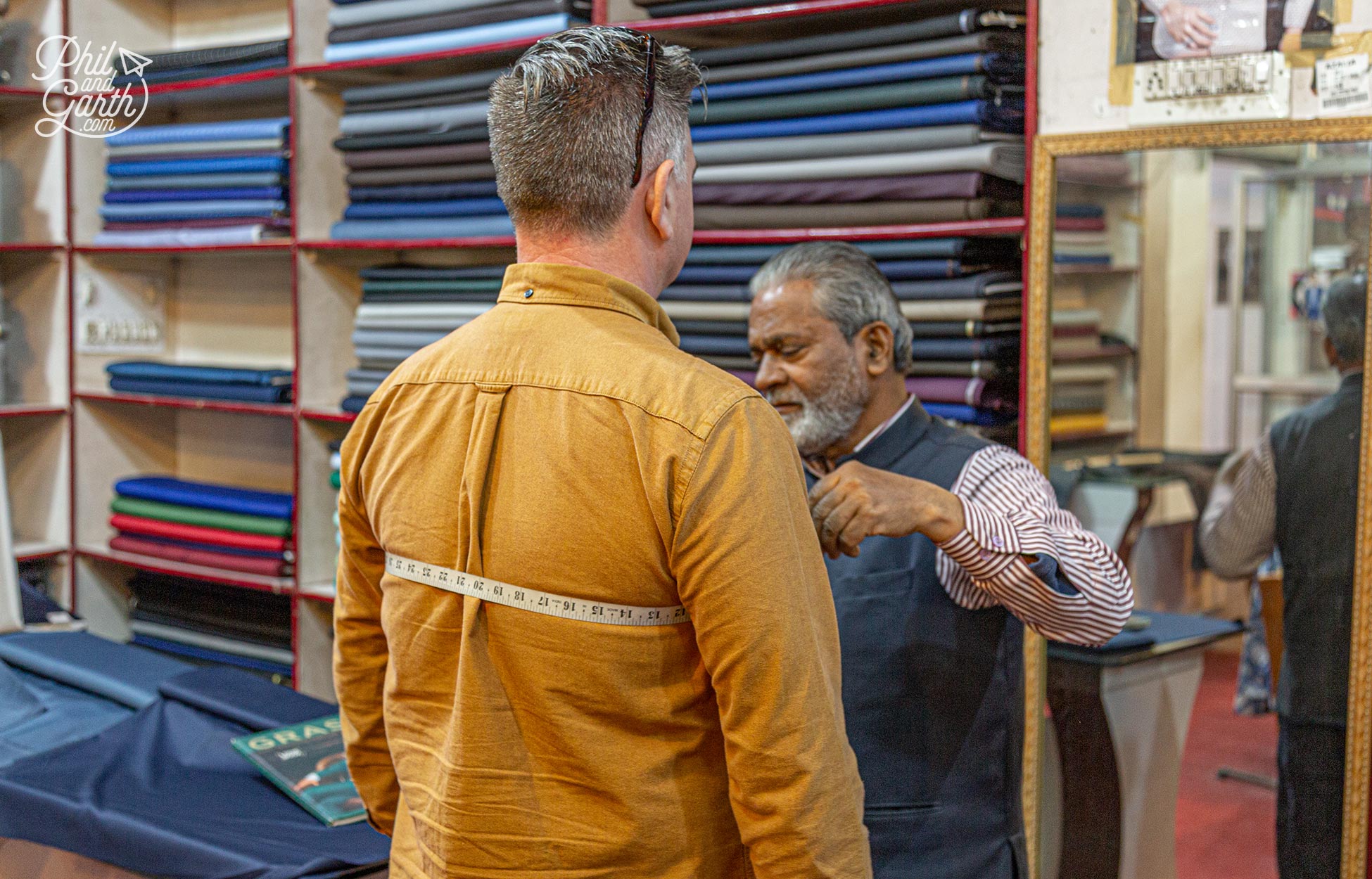
Phil getting measured up for a new suit

8 hours later, the end result!
Jaipur’s Gemstones
We also visited a gemstone factory to see craftsmen cut and polish emerald stones. It was interesting but not really our thing.

Seeing the process of making gemstone jewellery and Phil holding an emerald stone
9. Street Photography In Jaipur
As well as the fabulous palaces, Jaipur also offers an amazing amount of photo opportunities just by wandering around the streets and one of the many food markets. Here’s some of our favourite street photographs of Jaipur.

Indians really know how to decorate their delivery trucks!

Another fabulously decorated truck – Garth loved these for the bright graphics

Portrait of a street food vendor

A holy cow wandering the streets

Life on the busy streets of Jaipur

A local shop near to our haveli

A lady selling fresh herbs and vegetables
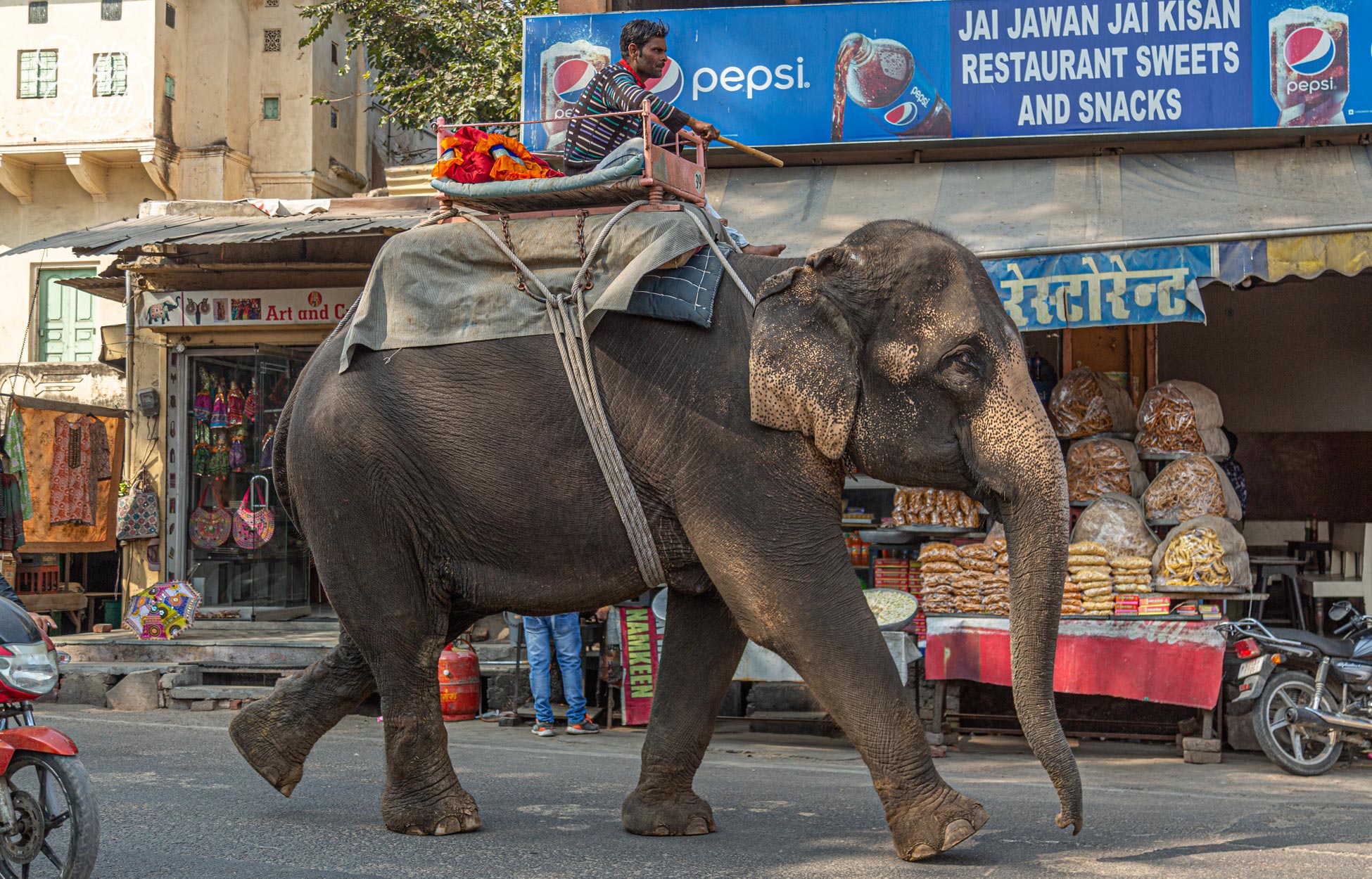
An elephant in the street isn’t a sight you see very often!

It’s actually very cold in the mornings during winter months

A fruit and veg stall on a street in Jaipur

A barber shop on the side of the road
10. Photograph A Traditional Haveli
We stayed in Jaipur’s oldest heritage hotel called The Bissau Palace. It’s a traditional and beautiful old haveli where we felt like Maharajas! Haveli’s are old merchant houses and mansions with fabulous architecture, lavishly decorated and usually have a courtyard with a fountain. Each evening it was lovely spending time relaxing in the sanctuary of the haveli away from the craziness of the streets outside. We could hear to the call to prayer at 6pm whilst we watched kites in the distance dancing in the sky.

The fabulous courtyard of the Hotel Bissau Palace

Some of the lovey interiors of our haveli
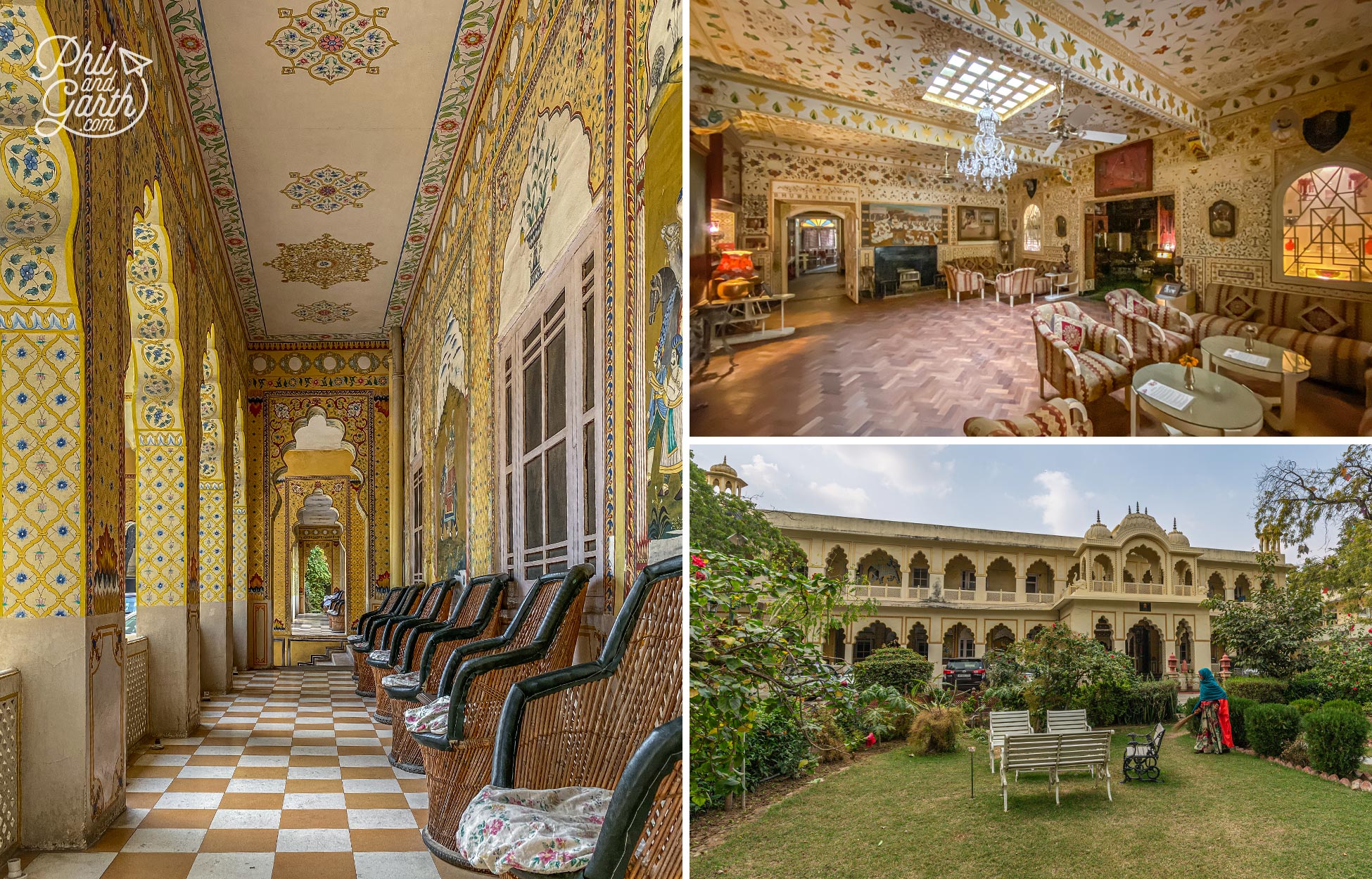
The Bissau Palace is Jaipur’s oldest heritage hotel
Getting Around Jaipur by Tuk Tuk
The most convenient and easiest way to get around Jaipur is by tuk tuk. Don’t bother with a boring old Uber taxi, you’re in India after all so embrace the tuk tuk! They are so much fun weaving in and out of the traffic, dodging other tuk tuks, camels and cows on the road. Phil asked one driver what would happen if you hit a holy cow – 7 years in prison! On another tuk tuk journey the driver was rather young and keen, he was going in and out of the traffic, swinging us all over the place. He turned round to us and said “I drive like in the movies yes?” we can confirm … he did!
Tuk tuks vary in size by cities in India – in Jaipur they seat 3 people however many drivers squeeze in lots more people. We occasionally would see a tuk tuk crammed full of people – Indians are so much slimmer than us fatties in western countries!
Make sure you bargain and settle on a price before you go anywhere. Now for the worst bit – nearly all our drivers asked us “Do you like shopping?” or “Do you want to see some gemstones?” or “I’ll take you to my brother’s restaurant”. We always gave a firm ‘no thank you, we’re not interested’ or ‘we need to get back to our hotel’ which seemed to do the trick. Stay alert for scams, but don’t be put off.
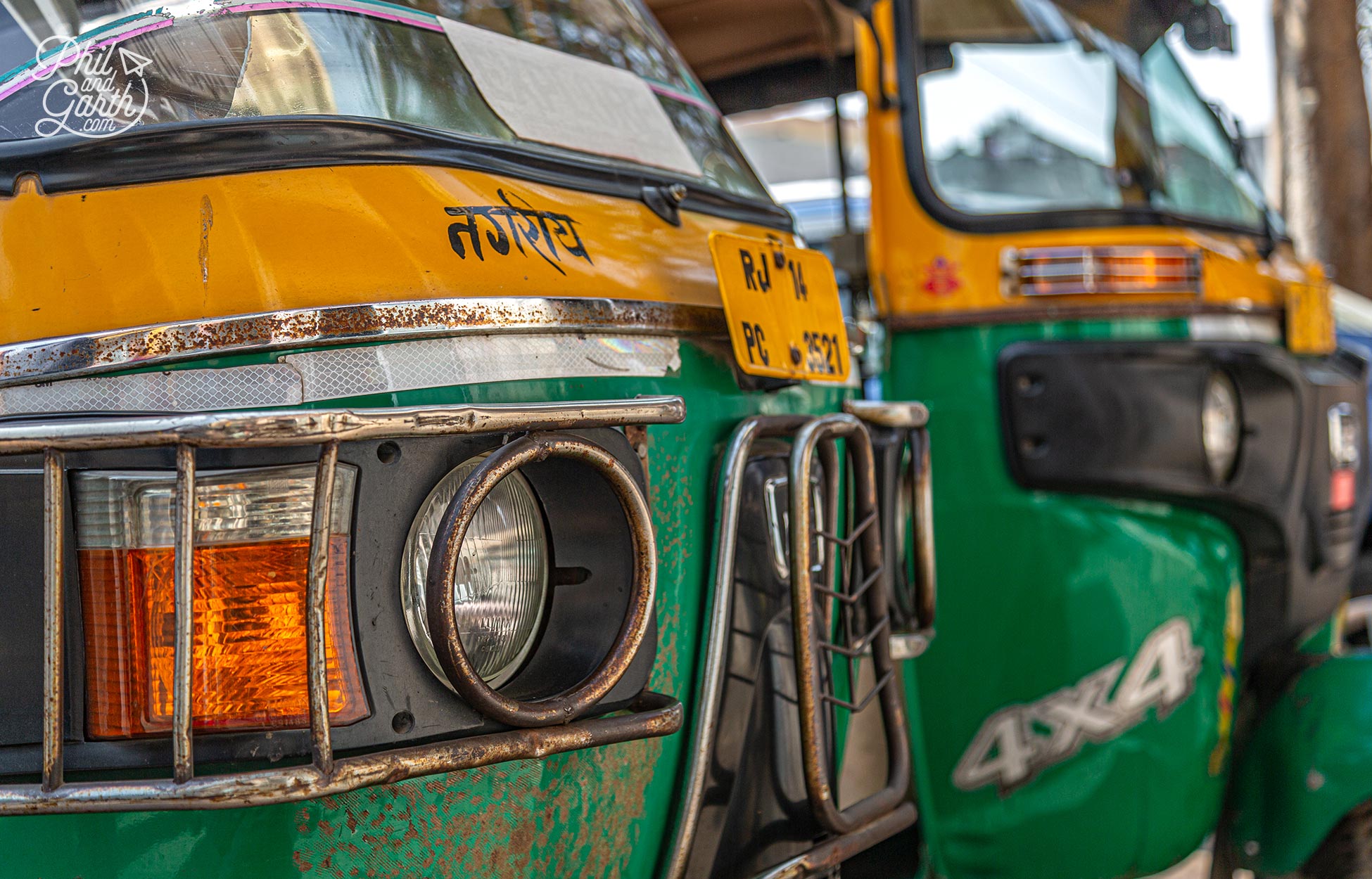
Tuk tuks are by far the easiest way to get around Jaipur

Hold on! Garth is driving!
Other Jaipur Attractions & Things To Do
- Albert Hall Museum – The best preserved and oldest museum in Rajasthan.
- Birla Temple – Marble Hindu temple devoted to Lord Vishnu and Goddess Lakshmi.
- Jaigarh Fort & Nahargarh Fort – Good for sunsets and taking in panoramic views.
- Galta Ji Temple – Or as locals call it Monkey Temple.
- Patrika Gate – An Instagrammers favourite spot for loads of colour.
Jaipur Practical Information & Useful Advice

Phil and Garth’s Top 5 Jaipur Tips
Phil and Garth’s Top 5 Jaipur Tips
- Tip #1: Expect to be hassled everywhere – Hawkers, rickshaw drivers, shop owners and lots of beggars.
- Tip #2:. When greeting locals say ‘Namaste’ and bring the palms of your hands together before your face or chest.
- Tip #3: In January temperatures drop fast in the evenings so wear lots of layers and take a jacket.
- Tip #4: Cash is key when shopping for anything and tip 10% for meals, like the UK.
- Tip #5: Try to visit Amber Fort as early as possible for photos without the crowds, it opens at 8am.
Jaipur FAQ
- What is the airport code for Jaipur? JAI – Jaipur International Airport (Sanganer).
- What time zone is Jaipur? GMT+5:30 – India Standard Time.
- What currency is used in Jaipur? Indian Rupee (Symbol: ₹)
- What language is spoken in Jaipur? Hindi, English and Dhundari.
- What is the population of Jaipur? 4,008,000.
- What number should I call in an emergency? Call 100 for Police, 101 for Fire and 102 or 108 for Ambulance.
- What electric plug type is used in Jaipur? Plug Types C, D & M. The 3 round pin type is the most common. Voltage is 230V / 50Hz.
- When is the best time to visit Jaipur? Best time to go is winter, November to February when it’s dry and warm.
- When is the worst time to visit Jaipur? Monsoon season runs from July to September.
- What is Jaipur famous for? Jaipur is famous for being India’s ‘pink’ city with some of India’s best preserved palaces.
- What’s the history of Jaipur? Jaipur was founded in 1727. Today it’s the largest city in India’s state of Rajasthan.
- What are the 5 must see sights of Jaipur? Hawa Mahal, Amber Fort, City Palace, Jantar Mantar and Chandpole Bazaar.
- What local food should I eat in Jaipur? Try the local dish Dal Bati Churma – a lentil dish served with hard bread rolls.
- What is the best way to get around Jaipur? Easily the best way to get around Jaipur is by tuk tuk.
- What’s an interesting fact about Jaipur? Jaipur hosts the world’s largest free literary festival visited by people from all over the globe.
- What movies have been filmed in Jaipur? The Best Exotic Marigold Hotel (2011), The Second Best Exotic Marigold Hotel (2015)
- Where is the best photo spot in Jaipur? From one of the rooftop cafes opposite the Hawa Mahal (see above).
- What is the best hidden gem in Jaipur? The Panna Meena Ka Kund stepwell near Amber Fort (see above).
- What is the best souvenir to buy in Jaipur? Textiles, silver jewellery, bangles, or fabric.
- What is the official Jaipur tourism website? Tourism Rajasthan click here for their website.
Jaipur Photography Locations Map
How We Did It
- We visited Jaipur at the end of January, the weather was perfect during the day for sightseeing – sunny and not roasting hot. We stayed for 2 nights at the Hotel Bissau Palace.
- We paid for a small group tour of India with Explore.






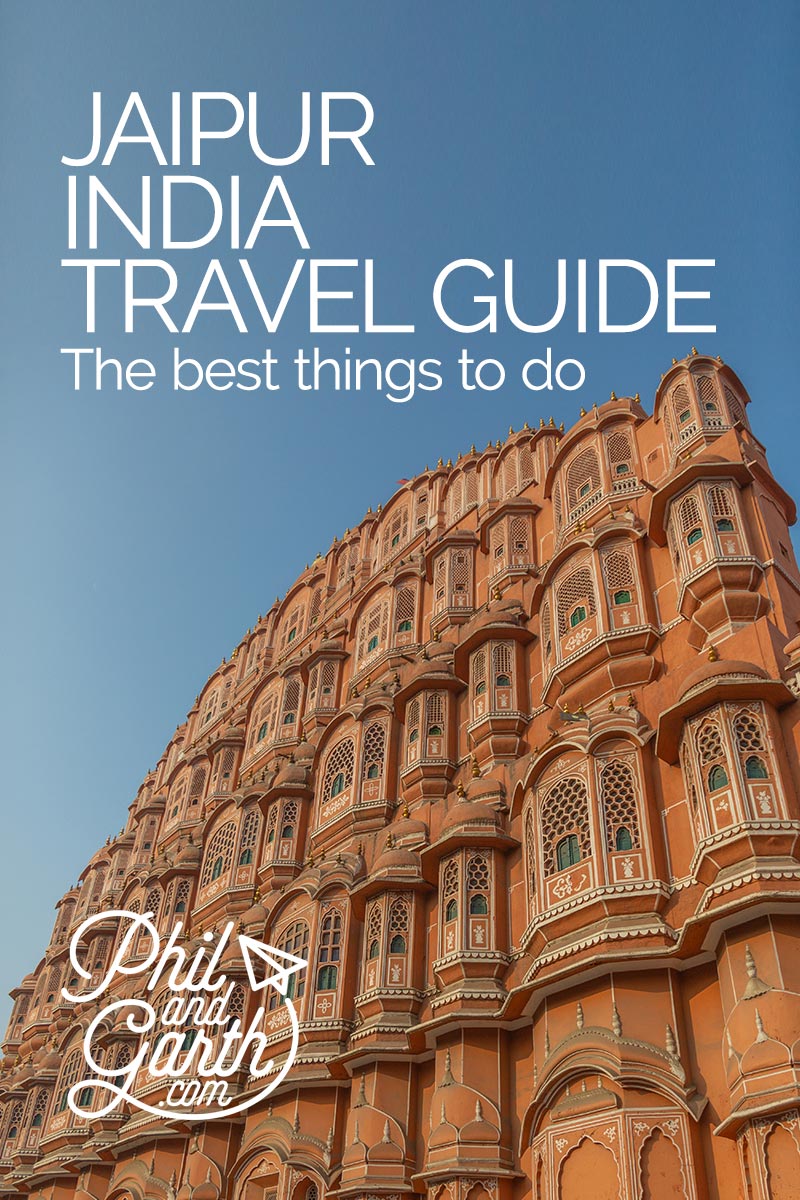


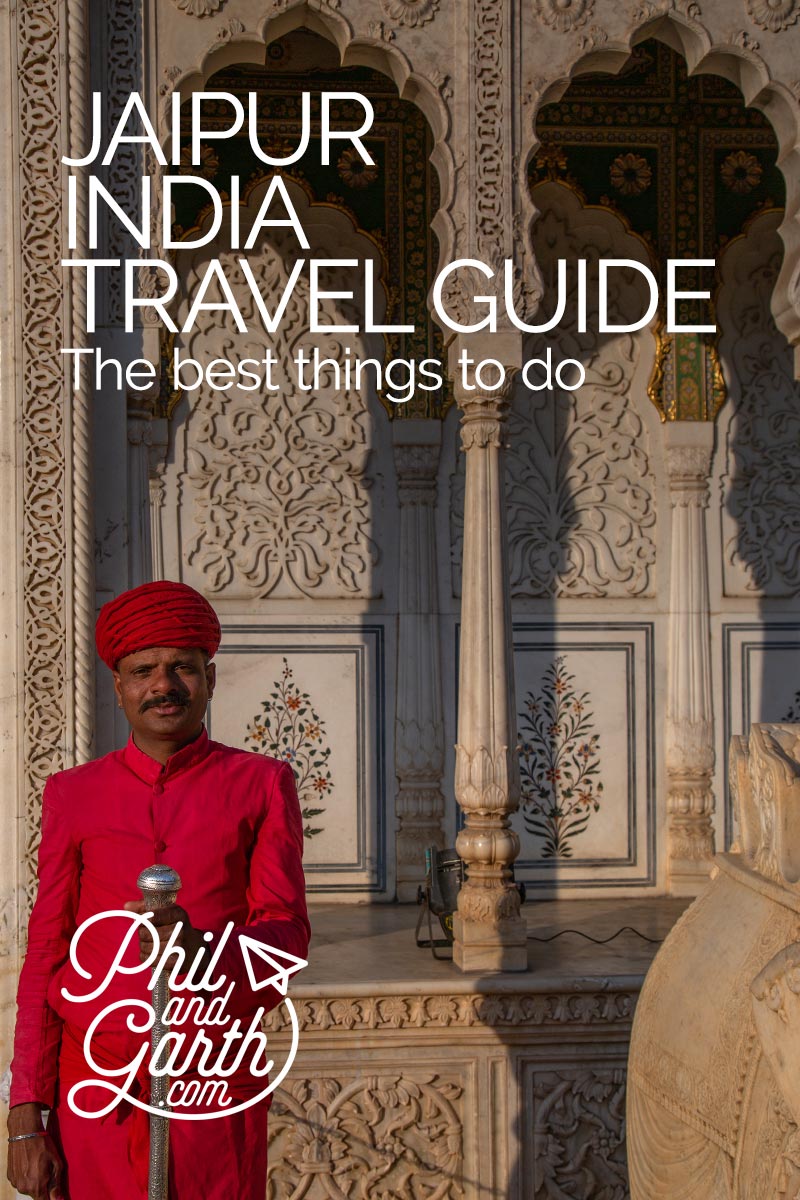
2 comments
Dear Phil and Garth
Greetings from Rome. Thank you so much for thee beautiful blogs, informative content, amazing photos, and your positive enthusiasm.
If you had to choose for a week end between Jaipur or Udaipur where would you go? Unfortunately, I have a limited time and I have to choose one city. Thank you for your kind attention. All the best. Paolo
Gosh that’s a difficult one! I liked Udaipur but Garth liked Jaipur! Let us know which one you went for.